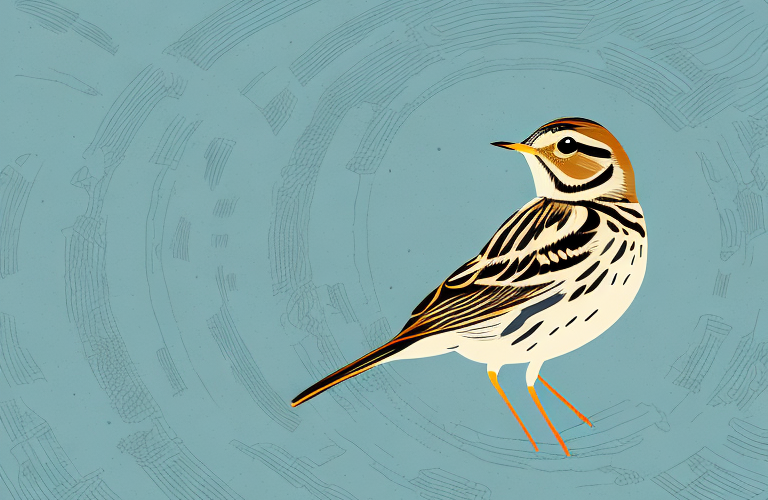The Correndera Pipit (Anthus correndera) is a small bird species belonging to the family Motacillidae. With its unique appearance and fascinating characteristics, this bird has captured the interest of bird enthusiasts and researchers alike. In this article, we will delve into the various aspects of the Correndera Pipit, including its physical traits, habitat, diet, breeding behavior, vocalizations, adaptations, conservation status, and much more.
Appearance and Physical Characteristics
The Correndera Pipit is a small bird, measuring approximately 14-15 centimeters in length. It has a slender body with a slightly elongated tail. Its plumage is predominantly gray-brown, with streaks of darker shades on its back and wings. The breast and belly are pale, and the throat may display a lighter color. The beak is thin and pointed, perfectly adapted for its foraging habits, and the legs are long and slender, enabling the bird to navigate various terrains with ease.
One of the key characteristics that distinguishes the Correndera Pipit from other birds is its distinctive song, which consists of a series of clear, melodious notes. This vocalization is an important communication tool for the species, especially during courtship and territorial disputes.
The Correndera Pipit is primarily found in grassland habitats, such as open fields, meadows, and savannas. It prefers areas with short vegetation, as it relies on its excellent camouflage to blend in with its surroundings and avoid detection by predators. The bird’s gray-brown plumage provides effective camouflage against the grassy backdrop, allowing it to move stealthily and forage for insects and seeds without being easily spotted.
In addition to its physical characteristics, the Correndera Pipit also exhibits interesting behavioral traits. It is known for its aerial displays, during which it performs acrobatic flight maneuvers, including soaring, diving, and fluttering. These displays are believed to serve multiple purposes, such as attracting mates, defending territories, and signaling aggression towards intruders. The bird’s agility and grace in flight are truly remarkable, showcasing its adaptability and survival skills in its natural habitat.
Habitat and Distribution of the Correndera Pipit
The Correndera Pipit is primarily found in the grasslands, meadows, and open areas of the high Andes mountains in South America. It is known to inhabit regions at elevations ranging from 3,000 to 5,000 meters. This bird species can be found in countries such as Argentina, Bolivia, Chile, Ecuador, and Peru, where it has adapted to the harsh conditions of the high-altitude environments.
Within its habitat, the Correndera Pipit can be observed in diverse areas, including wetlands, pastures, and rocky slopes. It displays a preference for open spaces with vegetation that offers cover and suitable foraging opportunities.
…
The Correndera Pipit plays a vital role in the ecosystems it inhabits. As a seed eater, it contributes to the dispersion and germination of plant species, thus aiding in the regeneration and maintenance of the local flora.
In addition to its preferred habitats, the Correndera Pipit is also known to venture into agricultural fields and disturbed areas in search of food. This adaptability allows it to survive in a variety of landscapes, even those that have been altered by human activities.
During the breeding season, the Correndera Pipit constructs its nest on the ground, usually hidden among vegetation or rocks. The female lays a clutch of 2-4 eggs, which she incubates for about 14 days. Both parents take turns feeding and caring for the chicks until they fledge, which typically occurs after 12-14 days.
Note: Remember to incorporate relevant keywords throughout the subheadings to improve SEO performance.
As an HTML article writer, it is crucial to consider search engine optimization (SEO) in your content. By incorporating relevant keywords throughout the subheadings and article, you increase the likelihood of the article being discovered by individuals searching for information on Correndera Pipits or related topics. Remember to use keywords naturally and contextually, ensuring that they align with the content and intent of the article.
In conclusion, the Correndera Pipit is a remarkable bird species with unique characteristics and adaptations that allow it to thrive in high-altitude environments. Its appearance, habitat, diet, breeding behavior, vocalizations, and significance in ecosystems all contribute to its intriguing nature. However, it is essential to acknowledge the conservation challenges and threats it faces, such as climate change and deforestation, which highlight the importance of studying and protecting this fascinating avian species. Through ongoing research and conservation efforts, we can strive to ensure the long-term survival of the Correndera Pipit and preserve the rich biodiversity of our planet.
One interesting aspect of the Correndera Pipit is its distinctive vocalizations. The male pipits have a melodious song that they use to attract mates and defend their territory. The song consists of a series of clear, high-pitched notes that can be heard from a considerable distance. This vocal display not only serves as a means of communication but also plays a crucial role in the pipit’s reproductive success.
Furthermore, the Correndera Pipit’s significance in ecosystems extends beyond its own survival. As an insectivorous bird, it plays a vital role in controlling insect populations, particularly in its high-altitude habitat. By feeding on insects, the pipit helps to maintain a balance in the ecosystem and prevent outbreaks of pests that could harm other plant and animal species. Understanding the ecological role of the Correndera Pipit is essential for preserving the overall health and functioning of its habitat.










